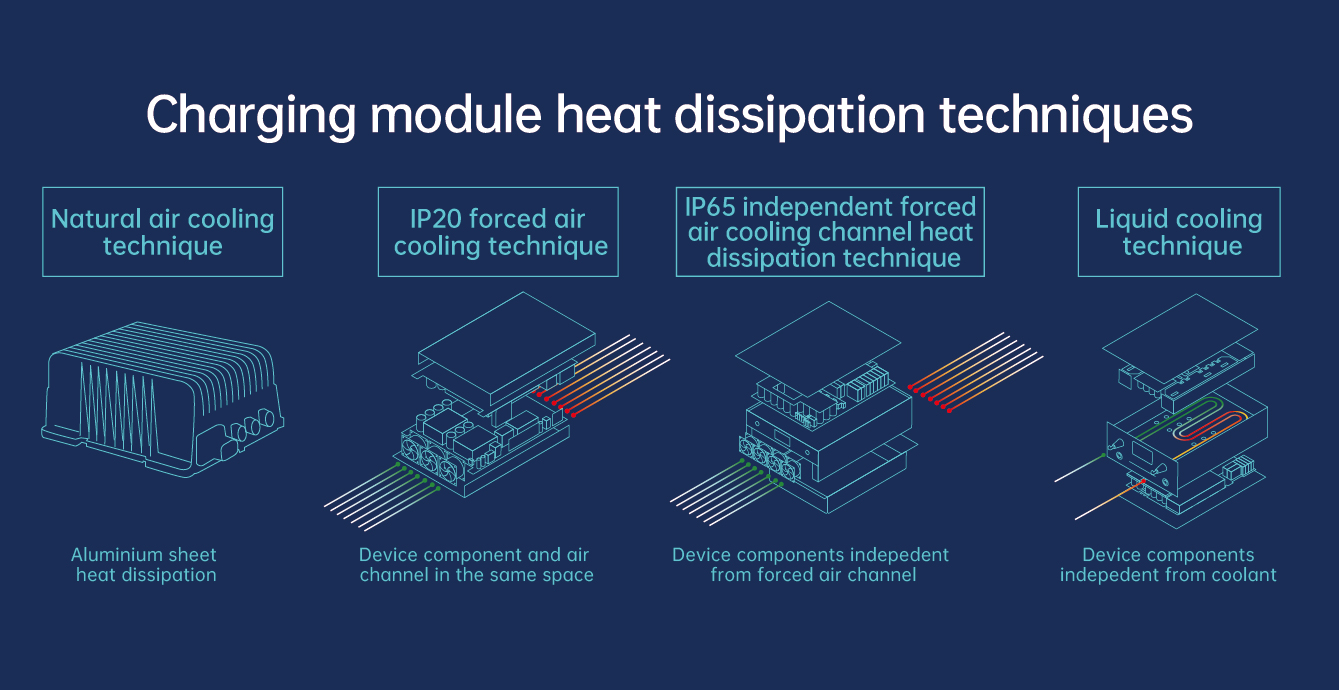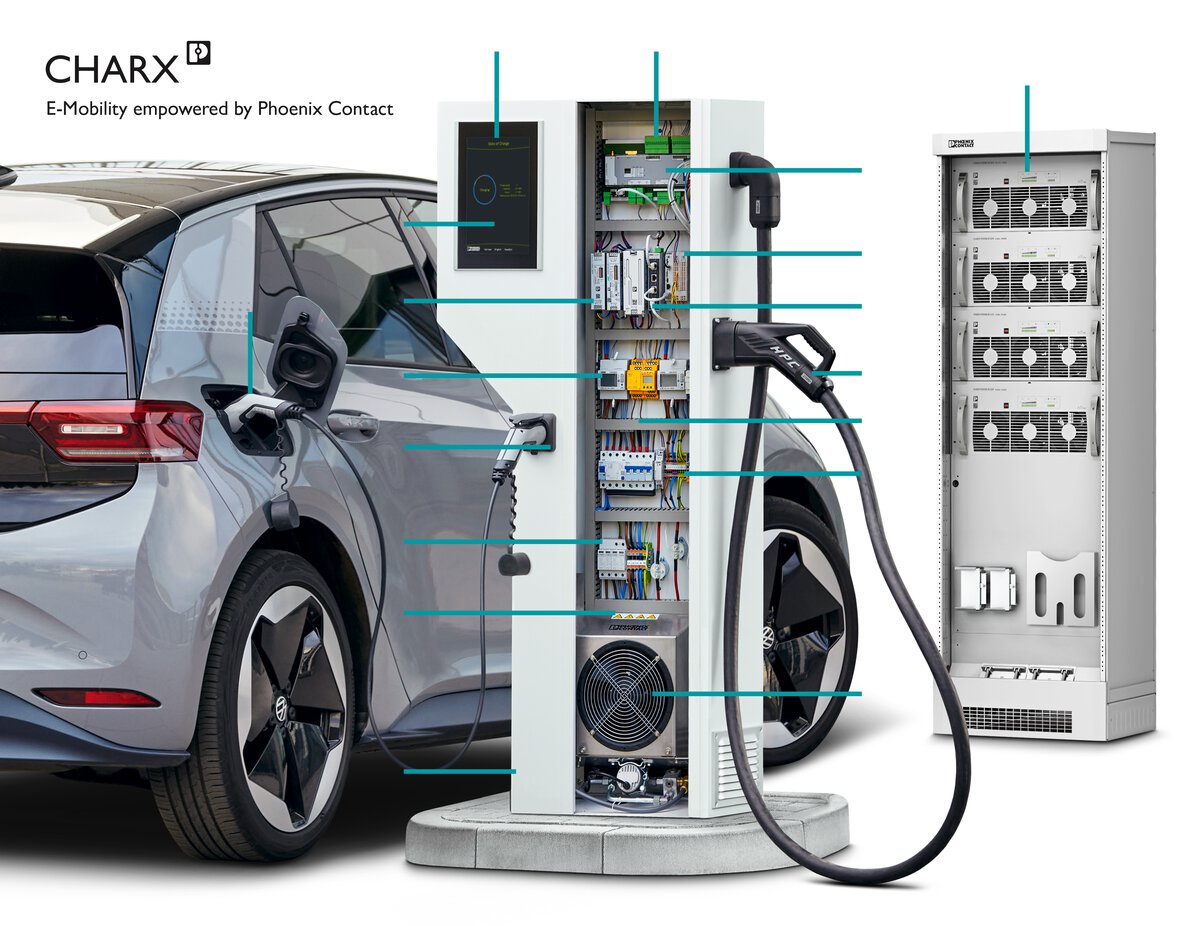When contemplating liquid cooling charging stations, one’s thought may naturally gravitate towards industry giants such as ChargePoint. ChargePoint, boasting a formidable market share of 73% in North America, prominently employs liquid cooling charging modules for their DC charging products. Alternatively, Tesla’s Shanghai V3 supercharging station, equipped with liquid cooling technology, may also come to mind.
ChargePoint Liquid Cooling DC Charging Station
Enterprises within the EV charging and battery swapping industry persistently innovate their technological approaches. Presently, charging modules can be categorized into two heat dissipation routes: forced air cooling route and liquid cooling route. Force air cooling solution expels heat generated by operational components via fan blade rotation, a method associated with increased noise during heat dissipation and the ingress of dust during fan operation. Notably, DC fast charging stations available on the market typically employ IP20-rated forced air cooling charging modules. This choice aligns with the imperative for rapid electric vehicle charging infrastructure deployment in its early stages within the country, as it affords cost-effective R&D, design, and production of charging facilities.
As we find ourselves ushering in the era of accelerated charging, the demands placed on charging infrastructure grow in tandem. Charging efficiency continually improves, operational capacity requirements intensify, and charging technology undergoes its necessary evolution. The application of liquid cooling technology to the charging domain has begun to take shape. A dedicated liquid circulation channel within the module facilitates the extraction of heat generated during the charging process. Furthermore, the internal components of liquid cooling charging modules remain sealed from the external environment, ensuring an IP65 rating, which elevates charging reliability and mitigates noise from charging facility operations.
Yet, investment costs become an emerging concern. The R&D and design costs associated with liquid cooling charging modules are comparably higher, resulting in a substantial increase in the overall investment required for charging infrastructure. For charging operators, charging stations represent the tools of their trade, and, in addition to operational revenue, factors such as product quality, service life, and after-sales maintenance costs assume considerable significance. Operators must seek to maximize economic returns throughout the life cycle, with initial acquisition costs no longer the primary determinant. Instead, service life and subsequent operational and maintenance expenses become the pivotal considerations.
Charging module heat dissipation techniques
Forced air cooling and liquid cooling represent distinct cooling routes for charging modules, both enhancing the performance, safety, and longevity of charging facilities by addressing issues of reliability, cost, and maintainability. Technically speaking, liquid cooling enjoys advantages in heat dissipation capacity, power conversion efficiency, and protective features. Nevertheless, from the vantage point of market competition, the key issue revolves around enhancing the competitiveness of charging equipment and catering to car owners’ needs for convenient and secure charging. The cycle for achieving a return on investment and meeting investment demands becomes a pivotal consideration.
In light of existing challenges within the traditional IP20 forced air cooling industry, including feeble protection, heightened noise levels, and harsh environmental conditions, UUGreenPower has pioneered original IP65-rated independent forced air channel technology. Diverging from conventional IP20 forced air cooling technique, the innovation effectively segregates components from air cooling channel, rendering it resilient to severe environmental conditions while requiring minimal maintenance. Independent forced air channel technology has garnered recognition and validation within sectors such as photovoltaic inverters, and its application in charging modules presents a compelling option for the advancement of high-quality charging infrastructure.
MIDA Power’s focus on amassing two decades of technology expertise in power conversion has materialized in the form of research and development and design of core components for electric vehicle charging, battery swapping, and energy storage. Its groundbreaking independent forced air channel charging module, distinguished by an IP65 high protection rating, has set a new benchmark for reliability, safety, and maintenance-free operation. Notably, it effortlessly adapts to a range of challenging EV charging and battery swapping environments, including sandy and dusty locales, coastal areas, high-humidity settings, factories, and mines. This robust solution tackles the persistent challenges of outdoor protection for charging stations.
Post time: Nov-08-2023

 Portable EV Charger
Portable EV Charger Home EV Wallbox
Home EV Wallbox DC Charger Station
DC Charger Station EV Charging Module
EV Charging Module NACS&CCS1&CCS2
NACS&CCS1&CCS2 EV Accessories
EV Accessories


